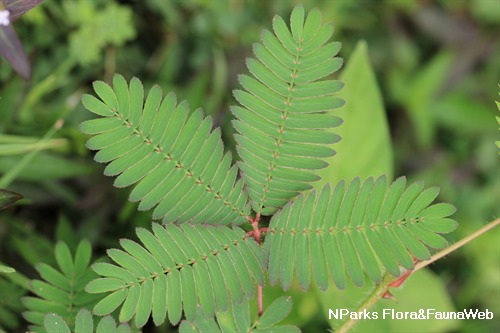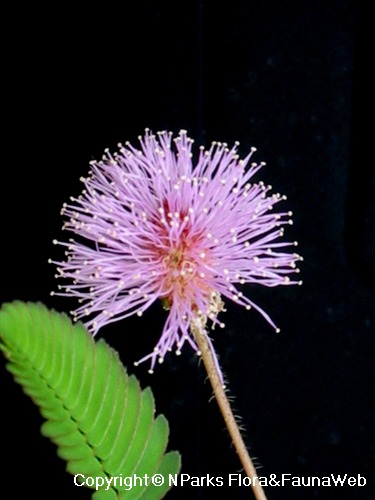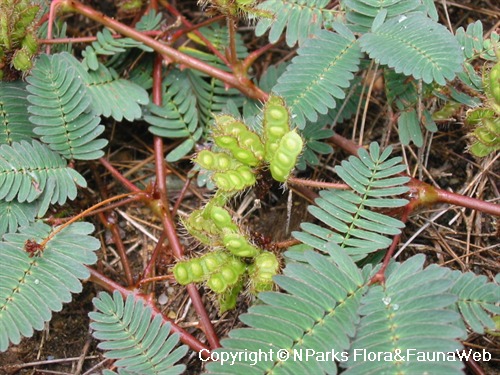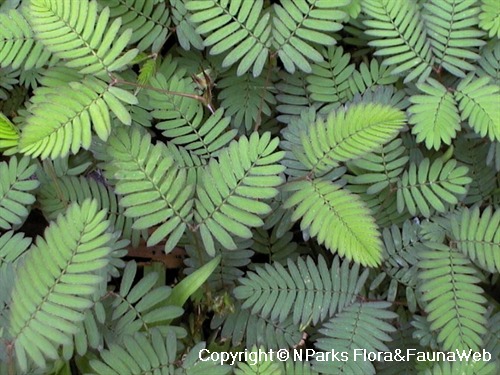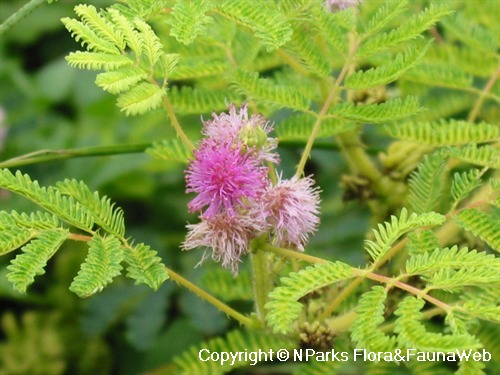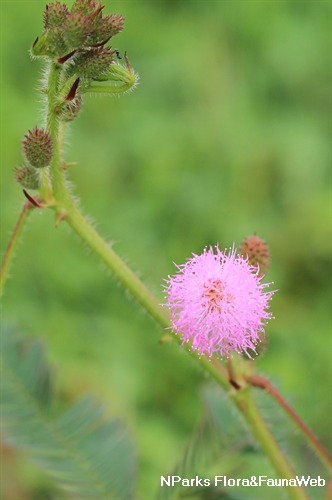
Back
Mimosa pudica L.
| Family Name: | Fabaceae (Leguminosae) |
| Common Name: | Sensitive Plant, Touch-me-not, Shame Plant, Live-and-die, Humble Plant, Action Plant, Rumput Simalu, Mimosa, Malu-malu, 含羞草 |
Name
Classifications and Characteristics
| Plant Division | Angiosperms (Flowering Seed Plants) (Dicotyledon) |
|---|---|
| Plant Growth Form | Shrub |
| Lifespan (in Singapore) | Perennial |
| Mode of Nutrition | Autotrophic |
Biogeography
| Native Distribution | Tropical America |
|---|---|
| Native Habitat | Terrestrial (Disturbed Area / Open Ground) |
| Preferred Climate Zone | Tropical |
Description and Ethnobotany
| Growth Form | Herb with creeping growth habit. |
|---|---|
| Foliage | Bipinnate leaves are composed of about 5 oblong pinnae. Each pinnae is made up of 15 - 20 pairs of oblong pinnules (0.5 cm long). The leaves fold and bend at night and upon being touched. A gentle touch will cause only the pairs of pinnules to fold, whereas a forceful touch will cause the entire leaf to droop from the base of the petiole. Leaves that have been stimulated to fold by touching require about 30 minutes to unfold. The touch-induced leaf movements may be an adaptation to deter herbivores. |
| Flowers | Pompom-shaped flowers (0.5 - 1 cm wide) are composed of hundred of thin strand-like petals. Small clusted or 5 - 8 flowers are borne in the leaf axils. |
| Cultivation | Although this species is often considered a weed in Singapore, it is sometimes grown in containers for its interesting ability to fold its leaves when touched. It should be planted in fertile, well-drained soil that is kept moist. Feed plants weekly with a half-strength, balanced fertilizer. Plants grow and flower best when slight rootbound, but re-pot them when roots have emerged from the drainage holes. Plants become unsightly after about a year, and new plants should be started if desired. Propagate by seeds. |
| Etymology | The genus "Mimosa" is Greek for mimic, and the specific epithet "pudica" is Latin for shy or shrinking. The genus and specific epithet both refer to how the leaves fold when touched. |
| Ethnobotanical Uses | Medicinal: A child is bathed in a decoction of the plant or a small branch placed under his pillow whenever there is difficulty in sleeping. Such practices, seen in Malaysia and Indonesia, originated from the 'sleeping' movement of the plant when touched. The pounded leaves are applied to swellings. In the Philippines, the leaves are soaked in coconut oil and placed on wounds and ulcers. It is also used to treat asthma. |
Landscaping Features
| Desirable Plant Features | Ornamental Flowers, Ornamental Foliage |
|---|---|
| Landscape Uses | Groundcover |
Fauna, Pollination and Dispersal
| Fauna Pollination Dispersal Associated Fauna | Butterfly Host Plant, Bee-Attracting |
|---|---|
| Pollination Method(s) | Biotic (Fauna) (Insects (Bee), Vertebrates (Other Mammal), Vertebrates (Human)), Abiotic (Wind, Water) |
Plant Care and Propagation
| Light Preference | Full Sun |
|---|---|
| Water Preference | Little Water |
| Rootzone Tolerance | Drought Tolerant, Easy to Grow |
| Maintenance Requirements | Low |
| Propagation Method | Seed |
Foliar
| Foliage Retention | Evergreen |
|---|---|
| Mature Foliage Colour(s) | Green |
| Mature Foliage Texture(s) | Smooth |
| Prominent Young Flush Colour(s) | Green |
| Young Flush Texture(s) | Smooth |
| Foliar Type | Compound (Even-Pinnate) |
| Foliar Arrangement Along Stem | Alternate |
| Foliar Attachment to Stem | Petiolate |
| Foliar Shape(s) | Non-Palm Foliage (Oblong) |
| Foliar Venation | Pinnate / Net |
| Foliar Margin | Pinnately Lobed / Pinnatifid |
| Leaf Area Index (LAI) for Green Plot Ratio | 4.5 (Shrub & Groundcover - Dicot) |
Non - Foliar and Storage
| Stem Type & Modification | Herbaceous |
|---|---|
| Root Type | Underground |
Floral (Angiosperm)
| Flower Colour(s) | Pink |
|---|---|
| Flower Grouping | Cluster / Inflorescence |
| Flowering Period | Free-Flowering |
Fruit, Seed and Spore
| Mature Fruit Colour(s) | Brown |
|---|---|
| Fruit Type | Dehiscent Dry Fruit , Legume / Pod |
Image Repository
Others
| Master ID | 931 |
|---|---|
| Species ID | 2225 |
| Flora Disclaimer | The information in this website has been compiled from reliable sources, such as reference works on medicinal plants. It is not a substitute for medical advice or treatment and NParks does not purport to provide any medical advice. Readers should always consult his/her physician before using or consuming a plant for medicinal purposes. |

